05-11-15 // DOMESTIC URBANISM

Room in New York, 1932 by Edward Hopper
Domestic Urbanism
By Bernd Upmeyer
Over the last three years we at MONU became increasingly interested in the question of ‘how should we live together?’ – a question that we analyzed, for example, in our issue #18 on “Communal Urbanism”, in which we focused on contemporary communal living in cities in general and on contemporary communal housing projects in particular. But at the same time we became more and more intrigued by the question of how life is organized in the indoor spaces of our cities and to what extent interiors become ever more urban, aspects that we investigated extensively in issue #21 entitled “Interior Urbanism”. Both questions and issues made us want to delve more deeply into the homes of people and we grew ever more fascinated by the domestic aspects of cities, by everything that is related to the human home, the habitat, and the scale of the house, people’s own universe, something that is usually hidden and private. We started to consider the house as one of the most meaningful spaces for urban people, a space to which everybody relates, where everybody spends most of his time and for which people are willing to pay the most. That is why we decided to dedicate an entire issue to a topic that we call “Domestic Urbanism”.
Thus, this new issue of MONU will deal with the question of how the homes of people are changing these days and how they will change in the future and what impact these changes will have on cities and their inhabitants. But this new issue will also examine how the contemporary city and the city of the future impacts and will impact the homes of people and the way people live in them. When we speak of homes and the “domestic”, we mean all kind of different forms of housing and dwellings that are used as permanent, semi-permanent or temporary residences for individuals, families, households or several families. They can be, for example, houses or apartments. Homes typically provide areas and facilities for sleeping, preparing food, eating, hygiene, leisure, but also increasingly for home entertainment, hosting guests and tourists, and for spaces to work at home.
We are excited to present a MONU issue on the topic of “Domestic Urbanism”, because we believe that a rather small urban unit, such as the apartment, can have a tremendous effect on a city and that – in turn – a city can have an incredible influence on homes and the way we live. That there is still a lot of creativity needed we experienced recently during our own research on major European metropolitan areas that are actually growing rapidly and again in need of huge numbers of new affordable housing units, offering a unique chance to re-evaluate and re-think the way we want to house ourselves. In the past, urban growth was something that we related to other places in the world and especially to cities in Asia, Africa, and parts of South America. Thus, with this new issue of MONU we aim to jump into a new era of innovation and to imagine and theorize about the unknown and experimental around the “domestic” and the topic of housing.
In order to be prepared for a future that is once again in desperate need of a revolution in housing, the design of floor plans, and strategies for typologies, we want to re-invent and evolve the concept of the “domestic” and the concept of the “home” radically. Because today, only around a third of the people, at least in the Western World, live in typical families, however houses did not adjust, as so often in the past, to the changing lifestyles of people and a changing society that becomes ever more diverse and mobile and in which people are participating more and more in the sharing economy.
Title: Domestic Urbanism
Author: Bernd Upmeyer
Date: November 2015
Type: Call For Submissions for MONU
Publications: MONU – Magazine on Urbanism
Location: Rotterdam, The Netherlands